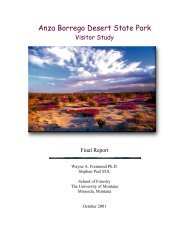Final Mitigated Negative Declaration and Response to Comments
Final Mitigated Negative Declaration and Response to Comments
Final Mitigated Negative Declaration and Response to Comments
Create successful ePaper yourself
Turn your PDF publications into a flip-book with our unique Google optimized e-Paper software.
Water Plant Community are<br />
not expected <strong>to</strong> be impacted<br />
by project activities.<br />
1 Regula<strong>to</strong>ry Status Codes:<br />
CE = California endangered<br />
FSS = United States Forest Service Sensitive<br />
FC = Federal C<strong>and</strong>idate for listing<br />
TRPA = Tahoe Regional Planning Agency threshold species or plant community of concern<br />
CNPS = California Native Plant Society Lists: List 1A = presumed extinct in California; List 1B = rare or<br />
endangered in California <strong>and</strong> elsewhere; List 2 = rare or endangered in California, more common elsewhere; List<br />
3 = need more information; List 4 = plants of limited distribution. New threat code extensions are: .1 = seriously<br />
endangered in California; .2 = fairly endangered in California; <strong>and</strong> .3 not very endangered in California.<br />
Plant Species with a Potential <strong>to</strong> Occur near the Project Area<br />
Five plants evaluated as potentially present near the project area occur near lake margins, or<br />
other wet systems (Table 4.1). Project activities will be conducted from a boat or barge <strong>and</strong><br />
work will occur underwater. None of these plants have the potential <strong>to</strong> occur in the project<br />
area. No operations from shore will be authorized in areas with potential habitat for any of<br />
these five plant species. Plant species also represented in the Deep Water Plant Community,<br />
of local concern, may have the potential <strong>to</strong> occur near the project area.<br />
Wildlife Species<br />
It is estimated that the Lake Tahoe Basin has 312 resident <strong>and</strong> migrant vertebrate species<br />
(Murphy <strong>and</strong> Knopp 2000). The following information is based on observations made by park<br />
staff <strong>and</strong> information obtained from the California Natural Diversity Database, the USFS<br />
LTBMU <strong>and</strong> other database queries.<br />
Mammals <strong>and</strong> birds use forested areas within the Lake Tahoe Basin for concealment, cover,<br />
nesting, denning, <strong>and</strong> foraging. Large mammals using this habitat include black bear (Ursus<br />
americanus), mule deer (Odocoileus hemionus), <strong>and</strong> mountain lion (Felis concolor). These<br />
large mammals have extensive home ranges <strong>and</strong> the same individual could conceivably<br />
frequent more than one park unit. Medium <strong>and</strong> small mammals observed in the park unit<br />
include coyote (Canis latrans), bobcat (Lynx rufus), raccoon (Procyon lo<strong>to</strong>r), porcupine<br />
(Erethizon dorsatum), long-tailed weasel (Mustela frenata), pine marten (Martes americana),<br />
golden-mantled ground squirrel (Spermophilus lateralis), lodgepole chipmunk (Tamias<br />
speciosus), Trowbridge’s shrew (Sorex trowbridgii), <strong>and</strong> deer mouse (Peromyscus<br />
maniculatus). Common bird species include dark-eyed junco (Junco hymenalis), western<br />
tanager (Piranga ludoviciana), mountain chickadee (Poecile gambeli), <strong>and</strong> red-breasted<br />
nuthatch (Sitta canadensis).<br />
Reptiles, amphibians, <strong>and</strong> fish comprise a relatively small percentage of the wildlife found in<br />
the Lake Tahoe Basin. In coniferous forest areas, lizard <strong>and</strong> snake species that may be found<br />
include western fence lizard (Sceloporus occidentalis) <strong>and</strong> western terrestrial garter snake<br />
(Thamnophis elegans). Most amphibians are dependent on streams, ponds, <strong>and</strong> other water<br />
bodies for reproduction <strong>and</strong> other aspects of their life. Amphibian species include Pacific tree<br />
frog (Hyla regilla). Fish species that occur include rainbow trout (Oncorhynchus mykiss), brook<br />
trout (Salvelinus fontinalis), Piute sculpin (Cottus beldingi), Lahon<strong>to</strong>n redside shiner<br />
Asian Clam Control Project IS/MND<br />
Emerald Bay State Park<br />
California Department of Parks <strong>and</strong> Recreation<br />
25
















